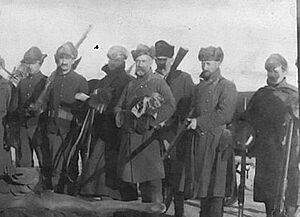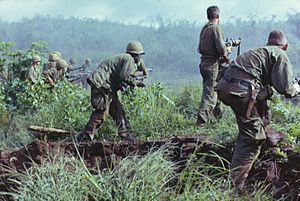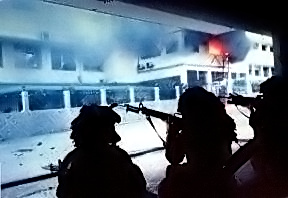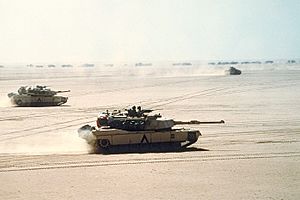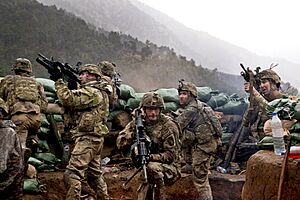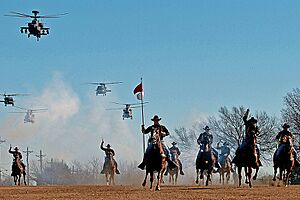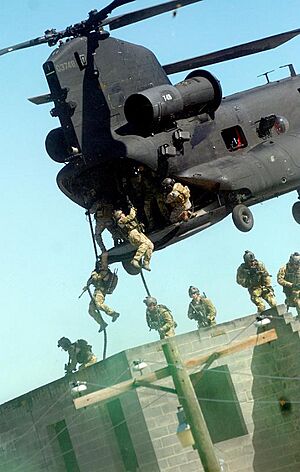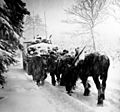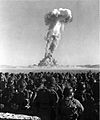United States Army facts for kids
Quick facts for kids United States Army |
|
|---|---|
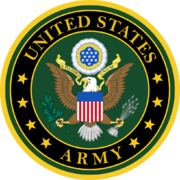 Service Mark of the United States Army  Wordmark |
|
| Founded | 3 June 1784 (241 years, 6 months) (in current form) 14 June 1775 (250 years, 5 months) (as the Continental Army) |
| Country | |
| Type | Army |
| Role | Land warfare |
| Size |
|
| Part of | United States Armed Forces Department of the Army |
| Headquarters | The Pentagon Arlington County, Virginia, U.S. |
| Motto(s) | "This We'll Defend" |
| Colors | Black, gold and white |
| March | "The Army Goes Rolling Along" |
| Mascot(s) | Army Mules |
| Anniversaries | Army Birthday: 14 June |
| Equipment | List of U.S. Army equipment |
| Engagements |
See list
Revolutionary War War of 1812 Mexican–American War Civil War Indian Wars Spanish–American War China Relief Expedition Philippine–American War Mexican Expedition World War I Russian Civil War World War II Korean War 1958 Lebanon crisis Vietnam War Dominican Civil War Korean DMZ Conflict Invasion of Grenada Invasion of Panama Somali Civil War Persian Gulf War Kosovo War Global War on Terrorism War in Afghanistan Iraq War Battle of Khasham |
| Commanders | |
| Commander-in-Chief | |
| Secretary of Defense | |
| Secretary of the Army | |
| Chief of Staff | |
| Vice Chief of Staff | |
| Chief Warrant Officer of the Army | CW5 Kevin B. Noblit |
| Sergeant Major of the Army | |
| Insignia | |
| Flag | 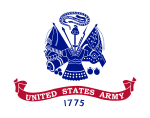 |
| Field flag |  |
| Logo | 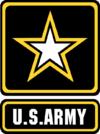 |
The United States Army (USA) is the main land-based part of the United States Department of Defense. It is known as the Army of the United States in the country's Constitution. The Army works under the guidance of the Secretary of Defense. It is one of the six armed forces and one of the eight uniformed services in the U.S. The Army is the oldest branch among the armed services.
Its beginnings trace back to the Continental Army, which formed on June 14, 1775. This army fought against the British for independence during the American Revolutionary War (1775–1783). After the Revolutionary War, the Congress of the Confederation created the United States Army on June 3, 1784. This new Army replaced the Continental Army, which had been disbanded.
The U.S. Army is part of the Department of the Army. This department is one of three military departments within the Department of Defense. A civilian leader, the Secretary of the Army (SECARMY), heads the U.S. Army. A chief military officer, the Chief of Staff of the Army (CSA), also leads it. The CSA is also a member of the Joint Chiefs of Staff.
The Army is the largest military branch. As of June 30, 2025, it has over 946,000 uniformed personnel. This includes active duty soldiers, Army National Guard members, and Army Reserve members. The Army's main job is "to fight and win our Nation's wars." It does this by providing strong land power in all types of military operations. The Army works worldwide as the main ground force for defense and offense for the United States.
Contents
- What is the U.S. Army?
- A Brief Look at Army History
- How the Army is Organized
- Special Operations Teams
- The Army Medical Department
- Army Personnel and Ranks
- Army Equipment and Gear
- Related pages
- Images for kids
- See also
What is the U.S. Army?
The United States Army is the main land-based part of the United States Department of Defense. It helps protect the country and its interests.
The Army's Main Goals
The Army's purpose is clearly defined in U.S. law. Its main goals include:
- Keeping the peace and safety of the United States. This also covers U.S. territories and any areas where U.S. forces are present.
- Supporting the country's overall plans and policies.
- Carrying out national goals.
- Stopping any nations that act aggressively and threaten the peace and safety of the United States.
How the Army Plans for the Future
In 2018, the Army shared its "Army Strategy 2018." This plan outlined goals for the Army up to 2028. While the Army's main mission stays the same, this strategy helps improve how the Army works. It focuses on larger groups of soldiers, like corps and divisions. The Army Futures Command leads efforts to update the Army for modern warfare. The Army's current plan to reorganize its forces is ongoing, with a goal to finish by 2028.
Key Skills of the Army
The Army has five main strengths:
- Fighting on land quickly and for long periods.
- Working with different types of military units, including tanks, armored vehicles, and airborne troops.
- Using special operations forces for unique missions.
- Preparing and supporting military operations for all branches of the armed forces.
- Combining national, international, and joint military power on land.
A Brief Look at Army History
How the Army Began
The Continental Army was formed on June 14, 1775. It was a unified army for the American colonies to fight against Great Britain. George Washington was chosen as its first commander. Early leaders learned from the British Army and colonial militias. Later, help from France also shaped the new army. European soldiers like Friedrich Wilhelm von Steuben taught the Army important tactics.

The Army fought many battles during the Revolutionary War. Sometimes, they used clever strategies to wear down British forces. Washington led important victories at Trenton and Princeton. With a major win at Yorktown and French support, the Continental Army won independence.
After the war, the Continental Army was disbanded. People at the time were wary of large standing armies. State militias became the main ground force. However, ongoing conflicts with Native American tribes soon showed the need for a trained army. The Regular Army was small at first. After a major defeat, it was reorganized as the Legion of the United States in 1791. It was renamed the United States Army in 1796.
In 1798, during a time of tension with France (the Quasi-War), Congress planned for a larger "Provisional Army." While these armies mostly existed on paper, equipment was gathered.
Major Conflicts of the 1800s
The War of 1812
The War of 1812 was the second and last major conflict between the United States and Great Britain. It involved fighting in the North, South, and at sea. Native American tribes fought on both sides. The war ended with the Treaty of Ghent. It led to over two centuries of peace between the two nations.
Seminole Conflicts
The U.S. had a long period of conflicts with the Seminoles in Florida, lasting over 50 years. Traditional military strategies were difficult to use against them. This was due to Florida's climate and the long history of conflicts among tribes in the region.
The Mexican-American War
The U.S. Army fought and won the Mexican–American War. This war was a very important event for both countries. The U.S. victory led to the Treaty of Guadalupe Hidalgo. This treaty gave a large amount of land to the United States. This land includes modern-day California, Nevada, New Mexico, Arizona, Texas, and parts of Colorado and Wyoming.
The American Civil War
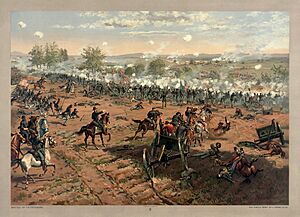
The American Civil War was the deadliest war in U.S. history. Many southern states, which allowed slavery, formed the Confederate States. They created the Confederate States Army. The United States (the "Union" or "the North") formed the Union Army. This army included regular units and many volunteers from all states except South Carolina.
The war lasted four years. The Union Army eventually won, leading to the end of slavery and the reunification of the country. The conflict resulted in the deaths of about 620,000 men on both sides.
Late 19th Century Army Roles
After the Civil War, the U.S. Army worked to manage Native American tribes on Indian reservations. They built many forts and fought in the last of the American Indian Wars. U.S. Army troops also stayed in several Southern states during the Reconstruction Era. Their job was to protect newly freed people.
The Spanish–American War of 1898 involved the Army in land campaigns in Cuba. The Army also played a key role in the Philippine–American War.
The Army in the 20th Century
Starting in 1910, the Army began using fixed-wing aircraft. During the Mexican Revolution, the Army was sent to U.S. border towns. This was to keep people and property safe. In 1916, a rebel leader named Pancho Villa attacked Columbus, New Mexico. This led to a U.S. military action in Mexico until 1917.
World Wars I and II

The United States joined World War I in 1917. U.S. troops went to the Western Front in Europe. They helped in the final attacks that ended the war in November 1918. After the war, the Army reduced its size.
In 1939, the Army had between 174,000 and 200,000 soldiers. General George C. Marshall then worked to make the Army larger and more modern for a possible war.
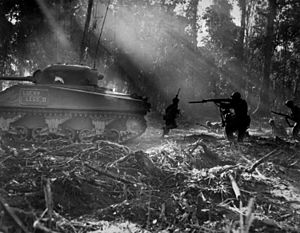
The United States entered World War II in December 1941. About 11 million Americans served in the Army during this war. On the European front, U.S. Army troops helped invade North Africa, Sicily, and Italy. They also played a central role in the landings in France in June 1944. This led to the liberation of Europe and the defeat of Nazi Germany.
In the Pacific War, U.S. Army soldiers fought alongside the United States Marine Corps. They helped capture Pacific Islands from Japanese control. After the war ended in 1945, Army troops occupied Japan and Germany. In 1947, the Army Air Forces became a separate branch, the United States Air Force. In 1948, President Harry S. Truman ordered the Army to end racial segregation.
The Cold War Era

After World War II, the world entered the Cold War. This was a period of tension between the East and West. When the Korean War began in June 1950, the U.S. sent hundreds of thousands of troops. They fought to prevent North Korea from taking over South Korea. The war ended in July 1953, returning the peninsula to its original state.

During the Cold War, U.S. troops also fought communist forces in Vietnam. The Vietnam War was a difficult time for the Army. U.S. forces were stationed in South Vietnam from 1959. Large numbers were deployed after 1965. They faced challenges against guerrilla tactics used by the Viet Cong and the North Vietnamese Army.
In the 1960s, the Army changed its reserve forces. The number of divisions in the Army National Guard was reduced. However, the total number of soldiers in the National Guard remained the same.
From Vietnam to the 1990s
After the Vietnam War, the Army adopted the "Total Force Policy." This policy treated the Regular Army, Army National Guard, and Army Reserve as one force. This meant that major operations would need all three parts of the Army. The Army also became an all-volunteer force. It focused more on training soldiers to high standards.
The 1980s saw the Army reorganize. The Goldwater-Nichols Act of 1986 created unified commands. These commands brought together all military services under single leaders for different regions or tasks. The Army also took part in operations in Grenada in 1983 and Panama in 1989.
As the Cold War ended around 1989, the Army began to plan for a smaller force. They aimed to reduce the number of soldiers.
The Gulf War and Peacekeeping
In 1990, Iraq invaded Kuwait. U.S. ground forces quickly moved to protect Saudi Arabia. In January 1991, Operation Desert Storm began. This was a U.S.-led effort with over 500,000 troops, mostly from the U.S. Army. They drove out Iraqi forces, achieving a complete victory. Some of the largest tank battles in history happened during the Gulf War.
After Operation Desert Storm, the Army did not have major combat operations for the rest of the 1990s. However, it did participate in several peacekeeping missions.
The Army in the 21st Century

On September 11, 2001, a terrorist attack hit the Pentagon. In response, U.S. and NATO forces invaded Afghanistan in October 2001. They removed the Taliban government. The U.S. Army also led the invasion of Iraq in 2003. It provided most of the ground forces for these operations. The mission later changed to fighting against insurgent groups. This resulted in the deaths of over 4,000 U.S. service members.
The Army has continuously worked on modernizing its equipment and organization. Projects like the Future Combat Systems program and BCT Modernization aimed to improve how the Army fights. By 2017, the Brigade Modernization project was finished. The Army has also adjusted its size and structure over the years to meet new challenges. For example, it retired many OH-58 Kiowa Warrior helicopters.
How the Army is Organized
Planning for Modern Needs
By 2017, a special group was formed to improve Army modernization. This led to changes in how units like the CCDC and ARCIC work. They moved under a new Army Command (ACOM) in 2018. This new command, Army Futures Command, focuses on designing new equipment and improving the process of getting it. The TRADOC defines how the Army is structured and trains soldiers.
Key Modernization Priorities
The Army Futures Command uses special teams to improve how the Army gets new equipment. To support these efforts, the Army's budget for 2020 set aside $30 billion for its top six modernization priorities over five years. This money came from saving costs and ending other projects.
Different Parts of the Army
The U.S. Army began organizing in 1775. For its first 100 years, it was a small force during peacetime. It mainly staffed forts and did engineering work. During wars, the Army grew with many United States Volunteers from different states. States also had their own militias that could join the Army.
In the 20th century, the "National Army" was created for World War I. After the war, it was replaced by the Regular Army, the Organized Reserve Corps, and state militias. In the 1920s and 1930s, "career" soldiers were in the "Regular Army." Reserve groups filled extra needs.
In 1941, the "Army of the United States" was formed for World War II. After that war, the reserve groups combined to form the United States Army Reserve. The Army of the United States was used again for the Korean War and Vietnam War.
Today, the Army has three main parts: the Regular Army, the Army Reserve, and the Army National Guard. Some states also have state defense forces. The Army is also divided into many different job areas, called branches and functional areas.
| Branch | Insignia and colors | Branch | Insignia and colors | Functional Area (FA) | |||
|---|---|---|---|---|---|---|---|
| Acquisition Corps (AC) | Air Defense Artillery (AD) |  |
Information Network Engineering (FA 26) | ||||
| Adjutant General's Corps (AG) Includes Army Bands (AB) |
Armor (AR) Includes Cavalry (CV) |
Information Operations (FA 30) | |||||
| Aviation (AV) | Civil Affairs Corps (CA) | Strategic Intelligence (FA 34) | |||||
| Chaplain Corps (CH) | Chemical Corps (CM) | Space Operations (FA 40) | |||||
| Cyber Corps (CY) | Dental Corps (DC) |  |
Public Affairs Officer (FA 46) | ||||
| Corps of Engineers (EN) | Field Artillery (FA) | Academy Professor (FA 47) | |||||
| Finance Corps (FI) | Infantry (IN) | Foreign Area Officer (FA 48) | |||||
| Inspector General (IG) | Logistics (LG) |  |
Operations Research/Systems Analysis (FA 49) | ||||
| Judge Advocate General's Corps (JA) | Military Intelligence Corps (MI) | Force Management (FA 50) | |||||
| Medical Corps (MC) |  |
Medical Service Corps (MS) | Acquisition (FA 51) | ||||
| Military Police Corps (MP) | Army Nurse Corps (AN) |  |
Nuclear and Counter WMD Officer (FA 52B) | ||||
| Psychological Operations (PO) | Medical Specialist Corps (SP) |  |
Simulation Operations (FA 57) | ||||
| Quartermaster Corps (QM) | Staff Specialist Corps (SS) (USAR and ARNG only) |
Army Marketing (FA 58) | |||||
| Special Forces (SF) | Ordnance Corps (OD) | Health Services (FA 70) | |||||
| Veterinary Corps (VC) |  |
Public Affairs (PA) | Laboratory Sciences (FA 71) | ||||
| Transportation Corps (TC) |  |
Signal Corps (SC) | Preventive Medicine Sciences (FA 72) | ||||
| Behavioral Sciences (FA 73) | |||||||
| Special branch insignias (for some unique duty assignments) | |||||||
| National Guard Bureau (NGB) | General Staff |  |
U.S. Military Academy Staff |  |
|||
| Chaplain Candidate |  |
Officer Candidate | Warrant Officer Candidate | ||||
| Aide-de-camp |
Senior Enlisted Advisor (SEA) |
||||||
Before 1933, Army National Guard members were state militia. They joined the U.S. Army only when called for war. Since 1933, all Army National Guard soldiers have a dual role. They serve under their state governor and as reserve members of the U.S. Army under the president.
Since the "Total Force Policy" after the Vietnam War, reserve soldiers have played a bigger role. They took part in the Gulf War, peacekeeping in Kosovo, operations in Afghanistan, and the 2003 invasion of Iraq.
Army Commands and Regional Groups
![]() Headquarters, United States Department of the Army (HQDA):
Headquarters, United States Department of the Army (HQDA):
| Army Commands | Current commander | Location of headquarters |
|---|---|---|
| GEN Andrew P. Poppas | Fort Bragg, North Carolina | |
| GEN James E. Rainey | Austin, Texas | |
| LTG Christopher O. Mohan (acting) | Redstone Arsenal, Alabama | |
| GEN Gary M. Brito | Fort Eustis, Virginia | |
| Army Service Component Commands | Current commander | Location of headquarters |
| LTG Patrick D. Frank | Shaw Air Force Base, South Carolina | |
| GEN Christopher T. Donahue | Clay Kaserne, Wiesbaden, Germany | |
| LTG Allan M. Pepin | Joint Base San Antonio, Texas | |
| GEN Ronald P. Clark | Fort Shafter, Hawaii | |
| MG Phillip J. Ryan | Joint Base San Antonio, Texas | |
| MG Lance G. Curtis | Scott AFB, Illinois | |
| LTG Maria B. Barrett | Fort Gordon, Georgia | |
| LTG Sean Gainey | Redstone Arsenal, Alabama | |
| LTG Jonathan P. Braga | Fort Bragg, North Carolina | |
| Operational Force Headquarters | Current commander | Location of headquarters |
| BG D. Sean Crockett (acting) | Camp Humphreys, South Korea | |
| Direct reporting units | Current commander | Location of headquarters |
| Katharine Kelley (civilian) | Arlington County, Virginia | |
| Civilian Protection Center of Excellence | Michael McNerney | Arlington County, Virginia |
| United States Army Joint Counter-Small Unmanned Aircraft Systems Office | Arlington County, Virginia | |
| Arlington County, Virginia | ||
| Craig A. Spisak (civilian) | Fort Belvoir, Virginia | |
| Carol Burton (civilian) | Aberdeen Proving Ground, Maryland | |
| LTG William H. Graham Jr. | Washington, D.C. | |
| BG Sarah K. Albrycht | Arlington County, Virginia | |
| Gregory D. Ford | Quantico, Virginia | |
| MG Hope C. Rampy | Fort Knox, Kentucky | |
| MG Timothy D. Brown | Fort Belvoir, Virginia | |
| LTG Mary K. Izaguirre | Joint Base San Antonio, Texas | |
| LTG Johnny K. Davis | Fort Knox, Kentucky | |
| BG Antoinette R. Gant | Fort Lesley J. McNair, Washington, D.C. | |
| MG David C. Hill | Carlisle, Pennsylvania | |
| LTG Steven W. Gilland | West Point, New York | |
| Source: U.S. Army organization | ||
How Army Units are Structured
The U.S. Army has three main parts: the active Regular Army, the Army National Guard, and the Army Reserve. The reserve parts are mostly part-time soldiers. They train once a month and have two to three weeks of annual training.

The Regular Army and Army Reserve follow rules under Title 10 of the United States Code. The National Guard follows rules under Title 32. When not in federal service, the Army National Guard is led by state governors. However, the District of Columbia National Guard reports to the U.S. president. The president can call any or all of the National Guard into federal service.
A civilian, the Secretary of the Army, leads the U.S. Army. This Secretary manages all Army affairs under the Secretary of Defense. The Chief of Staff of the Army is the highest-ranked military officer. This person advises the Secretary of the Army and is part of the Joint Chiefs of Staff. The Joint Chiefs advise the president and Secretary of Defense on military matters.
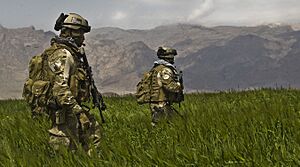
In 1986, the Goldwater–Nichols Act changed how the military works. It put operational control from the president to the Secretary of Defense. Then it goes directly to unified combatant commanders. These commanders control all units in their area. The Army provides trained forces to these commanders.
In 2013, the Army changed to six geographical commands. These match the six geographical unified combatant commands:
- United States Army Central in South Carolina.
- United States Army North in Texas.
- United States Army South in Texas.
- United States Army Europe and Africa in Germany.
- United States Army Pacific in Hawaii.
The Army also changed its main unit from divisions to brigades. Divisions still exist, but their headquarters can command any brigade. Each brigade is now modular, meaning all brigades of the same type are alike. This allows any division to command any brigade. The three main types of brigade combat teams are:
- Armored brigades, with about 4,743 troops.
- Stryker brigades, with about 4,500 troops.
- Infantry brigades, with about 4,413 troops.
There are also brigades that support combat and services. These include aviation brigades, artillery brigades, and military intelligence brigades. Combat service support brigades, like sustainment brigades, provide support roles.
Active Combat Units
The U.S. Army's main combat force includes 11 active divisions. It also has one division headquarters that does not deploy (7th Infantry Division). There are also several independent maneuver units.
From 2013 to 2017, the Army reduced its size after years of growth. In 2013, plans were made to shrink the active-duty force. However, these plans were later changed to expand the Army.
The Army's organization recently changed when United States Army Alaska became the 11th Airborne Division. This moved brigades from the 25th Infantry Division to focus on Arctic missions. As part of this, one Stryker Brigade Combat Team reorganized into an Infantry Brigade Combat Team. Now, the active Army has 11 Armored brigades, 6 Stryker brigades, and 14 Infantry brigades.
The Army National Guard and Army Reserve have eight more divisions. They also have 27 brigade combat teams and other support units. The Army Reserve provides almost all psychological operations and civil affairs units.
![]() United States Army Forces Command (FORSCOM)
United States Army Forces Command (FORSCOM)
| Direct reporting units | Current commander | Location of headquarters |
|---|---|---|
| LTG Xavier Brunson | Joint Base Lewis-McChord, Washington | |
| LTG Kevin Admiral | Fort Cavazos, Texas | |
| LTG Charles Costanza | Fort Knox, Kentucky | |
| LTG Christopher T. Donahue | Fort Bragg, North Carolina | |
| LTG Mark H. Landes | Rock Island Arsenal, Illinois | |
| LTG Robert Harter | Fort Bragg, North Carolina | |
| BG Kevin J. Lambert | Fort Bragg, North Carolina | |
| BG W M Bochat | Aberdeen Proving Ground, Maryland | |
| MG Richard A. Harrison | Fort Bliss, Texas | |
| COL Bryan C. Jones | Fort Novosel, Alabama |
| Active combat maneuver units | |||
|---|---|---|---|
| Name | Headquarters | Subunits | Subordinate to |
| 1st Armored Division | Fort Bliss, Texas | 3 armored brigade combat teams, 1st Armored Division Artillery (United States), 1 Combat Aviation Brigade, and 1 sustainment brigade | III Corps |
| 1st Cavalry Division | Fort Cavazos, Texas | 3 armored BCTs, 1st Cavalry Division Artillery (United States), 1 CAB, and 1 sustainment brigade | III Corps |
| Fort Riley, Kansas | 2 armored BCTs, 1 1st Infantry Division Artillery (United States), 1 CAB, and 1 sustainment brigade | III Corps | |
| 2nd Infantry Division | Camp Humphreys, South Korea Joint Base Lewis–McChord, Washington |
2 Stryker BCTs, 1 mechanized brigade from the ROK Army, 1 2nd Infantry Division Artillery (United States) (under administrative control of 7th ID), 1 sustainment brigade, and a stateside Stryker BCT from another active division that is rotated in on a regular basis. | I Corps (CONUS) Eighth Army (OCONUS) |
| 3rd Infantry Division | Fort Stewart, Georgia | 2 armored BCT, Divisional Artillery, Aviation Brigade, and 1 sustainment brigade | XVIII Airborne Corps |
| 4th Infantry Division | Fort Carson, Colorado | 2 Stryker BCT, 1 armored BCT, Divisional Artillery, 1 CAB, and 1 sustainment brigade | III Corps |
| 2nd Cavalry Regiment | Rose Barracks, Vilseck, Germany | 4 Stryker squadrons, 1 engineer squadron, 1 fires squadron, and 1 support squadron | U.S. Army Europe and Africa |
| 3rd Cavalry Regiment | Fort Cavazos, Texas | 4 Stryker squadrons, 1 fires squadron, 1 engineer squadron, and 1 support squadron (overseen by the 1st Cavalry Division) | III Corps |
| Joint Base Lewis–McChord, Washington | 1 CAB and 2 Stryker BCTs | I Corps | |
| 10th Mountain Division | Fort Drum, New York | 3 infantry BCTs, 1 10th Mountain Division Artillery (United States), 1 CAB, and 1 sustainment brigade | XVIII Airborne Corps |
| 11th Airborne Division | Joint Base Elmendorf–Richardson, Alaska | 1 airborne infantry BCT, 1 infantry BCT, 1 aviation command, and 1 sustainment battalion | I Corps |
| 25th Infantry Division | Schofield Barracks, Hawaii | 2 infantry BCTs, 1 DIVARTY, 1 CAB, and 1 sustainment brigade | I Corps |
| 82nd Airborne Division | Fort Bragg, North Carolina | 3 airborne infantry BCTs, 1 airborne DIVARTY, 1 airborne CAB, and 1 airborne sustainment brigade | XVIII Airborne Corps |
| 101st Airborne Division (Air Assault) | Fort Campbell, Kentucky | 3 infantry BCTs, 1 DIVARTY, 1 CAB, and 1 sustainment brigade | XVIII Airborne Corps |
| 173rd Airborne Brigade | Camp Ederle, Vicenza, Italy | 2 airborne infantry battalions, 1 airborne field artillery battalion, 1 airborne cavalry squadron, 1 airborne engineer battalion, and 1 airborne support battalion | Southern European Task Force, Africa |
| Name | Locations | Subunits |
|---|---|---|
| 28th Infantry Division | Pennsylvania, Ohio and Maryland | 2nd Infantry BCT, 56th Stryker BCT, 28th CAB, |
| 29th Infantry Division | Virginia, Maryland, North Carolina and Florida | |
| 34th Infantry Division | Minnesota, Wisconsin, Iowa and Idaho | 1st Armored BCT, 2nd Infantry BCT, |
| 35th Infantry Division | Kansas, Missouri, Illinois, Oklahoma, Georgia, Arkansas, and Nebraska | |
| 36th Infantry Division | Texas, Louisiana and Mississippi | 56th Infantry BCT, 72nd Infantry BCT, |
| 38th Infantry Division | Indiana, Michigan, Ohio and Tennessee | |
| 40th Infantry Division | Arizona, California, Hawaii, Oregon, and Washington | |
| 42th Infantry Division | Connecticut, Maine, Maryland, Massachusetts, New Hampshire, New Jersey, New York, Rhode Island, and Vermont | |
Special Operations Teams
![]() United States Army Special Operations Command (Airborne) (USASOC):
United States Army Special Operations Command (Airborne) (USASOC):
| Name | Headquarters | Structure and purpose |
|---|---|---|
| 1st Special Forces Command | Fort Bragg, North Carolina | Manages seven special forces groups. These groups deploy for nine missions, including unconventional warfare, foreign internal defense, and counter-terrorism. The command also manages two psychological operations groups. These groups work with foreign nations to support U.S. goals. A civil affairs brigade helps military leaders build relationships. A sustainment brigade provides combat and health support. |
| Army Special Operations Aviation Command | Fort Bragg, North Carolina | Organizes and trains Army special operations aviation units. These units provide quick air support to special operations forces. This includes five units, like the 160th Special Operations Aviation Regiment (Airborne). |
| 75th Ranger Regiment | Fort Benning, Georgia | This regiment has a headquarters, a special troops battalion, and a military intelligence battalion. It also has three battalions of elite airborne infantry. They specialize in large-scale operations and precision raids. Their missions include special reconnaissance, air assault, and seizing key locations. The Regiment also helps develop new equipment and training. |
| John F. Kennedy Special Warfare Center and School | Fort Bragg, North Carolina | This center selects and trains special forces, civil affairs, and psychological operations soldiers. It includes two groups and various training units. |
| 1st Special Forces Operational Detachment-Delta | Fort Bragg, North Carolina | Often called Delta Force, this is the U.S. Army's top-tier special unit. It performs the most complex and dangerous missions. Under the Joint Special Operations Command, Delta Force specializes in hostage rescue, counter-terrorism, and special reconnaissance. It has eight squadrons for different tasks. |
The Army Medical Department
The United States Army Medical Department (AMEDD) is the Army's main healthcare organization. It is led by the Surgeon General of the United States Army (TSG). The Surgeon General is a three-star lieutenant general. This person also commands the United States Army Medical Command (MEDCOM). The current Surgeon General is Lieutenant General Mary K. Izaguirre.
AMEDD includes six non-combat, medical specialty branches. These are the Medical Corps, Nurse Corps, Dental Corps, Veterinary Corps, and Medical Specialist Corps. Each branch has a chief who reports to the Surgeon General.
Army Personnel and Ranks
The Army uses a system called IPPS-A (Integrated Personnel and Pay System - Army). This system helps manage soldier information and pay. It is used by the National Guard, Army Reserve, and the active Army. Soldiers use this system for promotions and other career decisions.
One change is the Battalion Commander Assessment Program (BCAP). This program helps select future battalion commanders. It looks at an officer's personal preferences and many other factors. Promotion boards can now see all official information in an officer's record. Officers are encouraged to know their records and respond to any negative information. Other similar assessment programs are being considered for other ranks and commands.
Below are the U.S. Army ranks used today. The rank of General of the Army is still allowed during wartime, though no one currently holds it.
Officers: Leaders of the Army
There are several ways to become a commissioned officer. These include the United States Military Academy, Reserve Officers' Training Corps, Officer Candidate School, or direct commissioning. All officers wear the same insignia. Certain professionals, like doctors, nurses, lawyers, and chaplains, can become officers directly.
Most Army officers are promoted using an "up or out" system. This means they must be promoted or leave the service after a certain time. A more flexible system is now being used to manage talent. The Defense Officer Personnel Management Act of 1980 sets rules for promotions and the number of officers.
Army rules say to call all generals "General (last name)." Colonels and lieutenant colonels are called "Colonel (last name)." First and second lieutenants are called "Lieutenant (last name)."
| US DoD pay grade |
Special grade | O-10 | O-9 | O-8 | O-7 | O-6 | O-5 | O-4 | O-3 | O-2 | O-1 |
|---|---|---|---|---|---|---|---|---|---|---|---|
| NATO code | OF-10 | OF-9 | OF-8 | OF-7 | OF-6 | OF-5 | OF-4 | OF-3 | OF-2 | OF-1 | |
| Insignia |  |
||||||||||
| Army Green Service Uniform |  |
 |
 |
 |
 |
 |
 |
 |
 |
 |
 |
| Title | General of the Army | General | Lieutenant general | Major general | Brigadier general | Colonel | Lieutenant colonel | Major | Captain | First lieutenant | Second lieutenant |
| Abbreviation | GA | GEN | LTG | MG | BG | COL | LTC | MAJ | CPT | 1LT | 2LT |
Warrant Officers: Expert Specialists
Warrant officers are special officers who are experts in a specific field. They are first appointed as warrant officers (WO1) by the Secretary of the Army. They receive their official commission when promoted to Chief Warrant Officer Two (CW2).
By rule, senior officers call warrant officers "Mr. (last name)" or "Ms. (last name)." Enlisted personnel call them "sir" or "ma'am." However, many people in their units call warrant officers "Chief (last name)."
Enlisted Personnel: The Backbone of the Army
Sergeants and corporals are called NCOs (non-commissioned officers). Corporals are different from specialists, who have the same pay grade but do not lead others. Since 2021, all corporals must complete structured self-development for NCO ranks. They must finish the basic leader course (BLC) or be assigned as specialists. Specialists who finish BLC and are recommended for promotion can wear corporal rank before their official NCO promotion.
Privates and privates first class (E3) are called "Private (last name)." Specialists are called "Specialist (last name)." Corporals are called "Corporal (last name)." Sergeants, staff sergeants, sergeants first class, and master sergeants are all called "Sergeant (last name)." First sergeants are called "First Sergeant (last name)." Sergeants major and command sergeants major are called "Sergeant Major (last name)."
| US DoD pay grade | Special | E-9 | E-8 | E-7 | E-6 | E-5 | E-4 | E-3 | E-2 | E-1 | |||||
|---|---|---|---|---|---|---|---|---|---|---|---|---|---|---|---|
| NATO code | OR-9 | OR-8 | OR-7 | OR-6 | OR-5 | OR-4 | OR-3 | OR-2 | OR-1 | ||||||
| Dress uniform insignia |  |
 |
 |
 |
 |
 |
 |
 |
 |
 |
 |
 |
 |
No insignia |
|
| Service uniform insignia |  |
 |
 |
 |
 |
 |
 |
 |
 |
 |
 |
 |
 |
||
| Title | Senior enlisted advisor to the chairman | Sergeant major of the Army | Senior enlisted advisor to the chief of the National Guard Bureau |
Command sergeant major | Sergeant major | First sergeant | Master sergeant | Sergeant first class | Staff sergeant | Sergeant | Corporal | Specialist | Private first class | Private | Private |
| Abbreviation | SEAC | SMA | SEANGB | CSM | SGM | 1SG | MSG | SFC | SSG | SGT | CPL | SPC | PFC | PV2 | PV1 |
Training to Become a Soldier
Army training has two main parts: individual and collective. basic training lasts about 10 weeks. After this, recruits go to Advanced Individualized Training (AIT). Here, they learn skills for their specific job, called a military occupational specialty (MOS). Some MOSs combine Basic Training and AIT into one longer program called One Station Unit Training (OSUT). The length of AIT or OSUT depends on the job.
For example, Infantry OSUT was extended to 22 weeks in 2019. This training covers weapons like the M240 machine gun and the M249 squad automatic weapon. OSUTs for Armor, Cavalry, Engineer, and Military Police (MP) have also expanded.
Junior officers now serve as platoon leaders for Basic Combat Training (BCT) platoons. They handle many daily tasks and support drill sergeants. They also help ensure good behavior in their platoons.
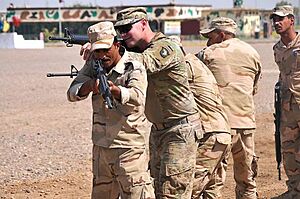
The Army Combat Fitness Test
The United States Army Combat Fitness Test (ACFT) was introduced in 2018. It is now the official fitness test for all soldiers. The test and scoring are the same for everyone, regardless of gender. It takes about an hour to complete. The ACFT replaced the older Army Physical Fitness Test (APFT). It is designed to better measure fitness for combat.
The ACFT has six events: three deadlifts, a standing power throw, hand-release pushups, a sprint/drag/carry event, leg tucks (or a plank), and a two-mile run. These movements are directly related to actions on the battlefield. All soldiers in the Regular Army, Reserve, and National Guard take this test.
After basic and advanced training, soldiers can get "additional skill identifiers" (ASI). This allows them to specialize further within their job. For officers, training includes pre-commissioning at places like USMA or through ROTC. After becoming officers, they get branch-specific training.
Collective training for units happens at their assigned bases. More intense training for larger groups takes place at three combat training centers (CTC):
- The National Training Center (NTC) in California.
- The Joint Readiness Training Center (JRTC) in Louisiana.
- The Joint Multinational Training Center (JMRC) in Germany.
The Army uses a process called ReARMM to prepare units for deployment. Individual soldiers also get training at the continental U.S. (CONUS) replacement center (CRC) before deploying. The Army continues to improve training for different environments, like cold weather, jungles, and urban areas.
Preparing Future Soldiers
The U.S. Army has faced challenges in finding enough new recruits. To help with this, the Army created the Future Soldier Prep Course (FSPC). This program helps potential recruits who might not meet the Army's fitness or academic standards at first.
In the fiscal year ending September 30, 2023, about 24% of new recruits went through the FSPC. This shows how important the program is for meeting recruitment goals. The FSPC offers both physical fitness and academic training. Most participants join the academic part, which teaches basic math, English, and other key skills.
Army Equipment and Gear
The Army's Chief of Staff has set six main goals for modernizing equipment. These are: artillery, ground vehicles, aircraft, communication networks, air/missile defense, and making soldiers more effective.
Weapons Used by Soldiers
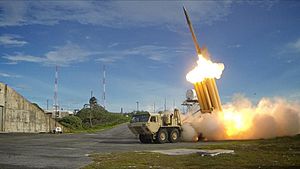
Individual Weapons
The U.S. Army uses various weapons for close-range fighting. The most common rifle is the M4 carbine. This is a smaller version of the M16 rifle. It is being slowly replaced by the M7 rifle in some units. The main handgun is the M17 pistol. Soldiers also use hand grenades, like the M67 fragmentation grenade and M18 smoke grenade.
Many units also have specialized weapons. The M249 SAW provides covering fire for squads. The M320 grenade launcher provides indirect fire. Shotguns like the M1014 or Mossberg 590 are used for breaking into buildings and close combat. Snipers use powerful rifles like the M107 Long Range Sniper Rifle and the M110 Semi-Automatic Sniper Rifle.
Team-Operated Weapons
The Army uses larger, team-operated weapons for heavy firepower over longer distances.
The M240 is the standard medium machine gun. The M2 heavy machine gun is often mounted on vehicles. The 40 mm MK 19 grenade machine gun is also mainly used by motorized units.
The Army uses three types of mortars for indirect fire support. The smallest is the 60 mm M224, used by infantry companies. Infantry battalions use 81 mm M252 mortars. The largest mortar is the 120 mm M120/M121, used by mechanized units.
Light infantry units get fire support from towed howitzers. These include the 105 mm M119A1 and the 155 mm M777.
The Army also uses rockets and missiles to give infantry anti-armor capabilities. The AT4 can destroy armor and bunkers. The FIM-92 Stinger is a shoulder-launched anti-aircraft missile. The FGM-148 Javelin and BGM-71 TOW are guided anti-tank missiles.
Army Vehicles

U.S. Army strategy relies heavily on mechanized warfare. It has one of the highest vehicle-to-soldier ratios in the world. The most common vehicle is the High Mobility Multipurpose Wheeled Vehicle (HMMWV), known as the Humvee. It can carry cargo, troops, weapons, or serve as an ambulance. The Army also uses many combat support vehicles, like the HEMTT family of trucks.

The M1A2 Abrams is the Army's main battle tank. The M2A3 Bradley is the standard infantry fighting vehicle. Other vehicles include the Stryker, the M113 armored personnel carrier, and various Mine Resistant Ambush Protected (MRAP) vehicles.
The Army's main artillery weapons are the M109A7 Paladin self-propelled howitzer and the M270 multiple launch rocket system (MLRS). Both are mounted on tracked platforms and used by heavy mechanized units.
Army Aviation: Helicopters and More
The United States Army Aviation Branch mainly uses helicopters. These include the AH-64 Apache attack helicopter, the UH-60 Black Hawk transport helicopter, and the CH-47 Chinook heavy-lift helicopter. The Army has reduced its aircraft types and numbers as part of restructuring plans.
The Army is also looking at new fixed-wing aircraft to replace its current ISR (Intelligence, surveillance, and reconnaissance) planes. For UAVs (drones), the Army is deploying MQ-1C Gray Eagle drones to each active Army division.
Soldier Uniforms
The Army Combat Uniform (ACU) now features the Operational Camouflage Pattern (OCP). This pattern replaced the older pixel-based pattern in 2019.
On November 11, 2018, the Army announced a new version of 'Army Greens.' These uniforms are based on those worn during World War II. They are now the standard everyday service uniform. The blue Army Service Uniform remains the dress uniform. The Army Greens were first issued in the summer of 2020.
Berets: Special Headwear
The beret flash on enlisted personnel's berets shows their unit's unique symbol. The U.S. Army's black beret is no longer worn with the ACU for daily duty. It has been replaced by the patrol cap.
Soldiers in units that perform parachute jumps still wear berets (maroon beret). Members of Security Force Assistance Brigades (SFABs) wear brown berets. Members of the 75th Ranger Regiment and Special Forces wear tan or rifle green berets. They can wear these with the Army Service Uniform for non-ceremonial events. Unit commanders can still order the use of patrol caps during training.
Army Tents and Shelters
The Army uses many tents for facilities during deployments. These tents serve as temporary barracks (sleeping areas), dining facilities, and command centers. They are also used for recreation and security checkpoints. Many of these tents are set up with support from the Natick Soldier Systems Center.
Each Force Provider Expeditionary (FPE) tent system includes sleeping, bathroom, shower, laundry, and kitchen facilities for 50–150 soldiers. These systems are stored in Army Prepositioned Stocks. This allows commanders to quickly place soldiers where needed.
The U.S. Army now uses a more modern tent called the deployable rapid assembly shelter (DRASH). Since 2008, DRASH has been part of the Army's standard command post system.
Related pages
- United States National Guard
- United States Army Reserve
- United States Army Center of Military History
Images for kids
-
American soldiers hunt Japanese infiltrators during the Bougainville Campaign.
-
Men of the 3rd Battalion, 504th Parachute Infantry Regiment, part of the 82nd Airborne Division, advance in a snowstorm, January 1945.
-
U.S. Army soldiers look upon an atomic bomb test of Operation Buster-Jangle at the Nevada Test Site during the Korean War.
-
U.S. Army soldiers prepare to take La Comandancia in Panama City during the United States invasion of Panama.
-
Army Rangers from the 1st Ranger Battalion conduct a MOUT (Military Operations in Urban Terrain) exercise at Fort Bragg, North Carolina.
-
U.S. soldiers from the 6th Infantry Regiment taking up positions during a foot patrol in Ramadi, Iraq.
-
U.S. Army Special Forces soldiers from the 3rd Special Forces Group patrol a field in Afghanistan.
-
Rangers practice fast roping techniques from an MH-47 during an exercise at Fort Bragg.
-
Lockheed Martin Terminal High Altitude Area Defense (THAAD) system used by the army for ballistic missile protection.
-
American troops of the 28th Infantry Division march down the Champs-Élysées, in the victory parade following the Liberation of Paris.
See also
 In Spanish: Ejército de los Estados Unidos para niños
In Spanish: Ejército de los Estados Unidos para niños
- Army and Navy stamp issues of 1936–1937
- History of the United States Army
- List of military weapons of the United States
- Junior Reserve Officers' Training Corps
- List of active United States military aircraft
- List of comparative military ranks
- List of former United States Army medical units
- List of wars involving the United States
- Reorganization plan of United States Army
- Soldier's Creed
- Timeline of United States military operations
- U.S. Army Combat Arms Regimental System
- U.S. Army Regimental System
- United States Army Basic Training
- United States Constabulary (United States Gendarmerie)
- Social history of soldiers and veterans in the United States


